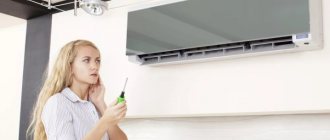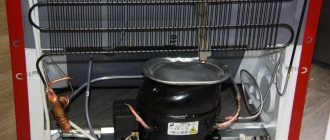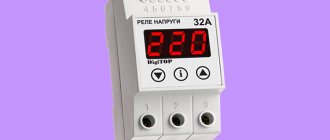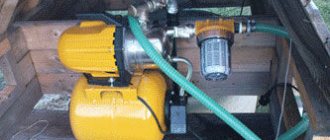Inverter refrigerators are an attractive alternative to linear models. The main difference between this option is the automatic change in speed and noiselessness. In 2021, the demand for a device with such a compressor is growing. Therefore, it is important to know the advantages and disadvantages of the equipment. This will help you make the right choice and find a suitable model without going into detailed technical specifications.
The editors of the YaNashla website have prepared for you a rating of the best inverter refrigerators for 2021.
What is an inverter compressor in a refrigerator?
Digital inverter control technologies are used not only in the production of refrigeration equipment. These compressors are also used in the production of computer, medical, automotive and instrumentation equipment.
The engine operates on the principle of converting alternating current into direct current. After this, a new adjustment occurs to the desired frequency.
All control is carried out using a special board.
How does it work
The principle of operation of the inverter refrigerator compressor is that after turning it on, the required temperature threshold is reached very quickly. Thanks to this operation, the cooling temperature can be maintained at an optimal level for a long time.
This compressor does not turn off, but only slows down. It continues to operate at the power that is sufficient to maintain the desired temperature in the refrigeration chamber, while the speed of the refrigerant is slightly slowed down.
The difference between an inverter compressor and a conventional one
The operation of a simple linear compressor differs in many ways from that of an inverter. The first one picks up maximum engine speed and then turns off when the desired temperature is reached.
This process is regulated using a special relay. If you listen closely, you can hear a characteristic click when the engine turns off.
At the same time, the inverter type of compressor consumes less electricity, and the temperature can be maintained constantly at the same level.
How does a refrigerator work?
The refrigeration unit is a closed hydraulic system filled with a special coolant - refrigerant . Freons are used as a refrigerant in domestic refrigeration units, and ammonia is used in industrial ones.
A compressor , driven by an electric motor, pumps refrigerant through the entire system. As it passes through different sections of the refrigeration unit, the refrigerant changes its state of aggregation, its temperature and pressure change.
Inside the refrigerator itself there is a special coil called an evaporator . The refrigerant is supplied to the evaporator in a liquid state at low pressure and temperature. Without going into the complexities of thermodynamics and without constructing heat balance equations, I will say that in the evaporator, heat is removed (i.e., heating) from warmer products, the walls of the refrigeration chamber. Through the walls of the evaporator, heat is transferred to the refrigerant and it begins to boil because it is at a low temperature and under low pressure.
How does a refrigerator work?
Further from the evaporator, gaseous refrigerant is sucked through the inlet valve by the compressor, compressed by the piston, its temperature rises, and under high pressure it is pushed into the condenser .
We all know the condenser well - it is a coil on the back wall of the refrigerator. Passing through the condenser, the refrigerant vapors give off their heat through the condenser machines to the surrounding room. The refrigerant cools and turns into a liquid state.
Next, the liquid refrigerant is pushed to the pressure reducing valve . Passing through this valve, the pressure and temperature of the refrigerant decrease and it again enters the evaporator. Then the whole cycle repeats again.
Differences between an inverter compressor and a conventional one
Regardless of the type of refrigerator compressor, they are all divided into two categories - conventional and inverter. Conventional compressors are also called non-inverter, start-stop or On/Off. Below is a description of how conventional and inverter compressors work in refrigerators.
How does a regular compressor work?
Equipment equipped with a conventional compressor functions as follows:
- The compressor turns on and runs until the temperature in the refrigerator reaches the desired value;
- After the chamber has cooled, the compressor is turned off;
- The temperature in the compartment gradually drops due to heat loss;
- When the sensor detects a decrease in temperature by 1-2 degrees, the compressor turns on again.
A conventional compressor always runs at the same speed , regardless of type. Cooling only occurs when it is turned on. The speed of the refrigerator compressor motor is not regulated in any way; it either works or it doesn’t.
Operating principle of an inverter compressor
Refrigerators with an inverter compressor work differently:
- The compressor turns on and operates at full power until the compartment cools down to the set temperature;
- After this cooling, it does not stop, but reduces the operating speed to a minimum, maintaining the temperature regime;
- If the temperature in the chamber rises sharply (if the door is open or you put something heated in the refrigerator), the operating speed increases;
- More intensive cooling occurs; when the desired temperature is reached, the compressor again operates at minimum power.
The inverter compressor runs constantly, but its operating speed may vary . The more the temperature in the chamber differs from the norm, the more intensely it works. Accordingly, the refrigerator cools the chamber faster.
What are the causes of breakdowns?
The weak point of the inverter compressor is the electronic control unit. This module is very sensitive to voltage drops in the network, which provoke various failures and errors in its operation. Repairing the unit costs a decent amount, not to mention completely replacing the compressor.
To avoid such costs, you should use a network stabilizer.
Operating principle of a linear compressor
Most refrigeration equipment (
80%) for home use operates on linear compressors. Modern noise accompaniment of the operation of units is incomparable with the sound that old devices produced, i.e.
That is, now the background noise is much lower.
This phenomenon is explained by the fact that older models used equipment with a crank system operating under the influence of torque. New devices operate on electromagnetic radiation from the windings of an electric motor, providing translational motion in the pistons on a single plane.
Therefore, the compressor is called “linear”.
The operating principle of such installations:
- A temperature control indicator is installed in the freezer compartment. Analysis by the indicator is carried out in a continuous mode, i.e., through this sensor, current information is collected and reconciliation with accepted standards occurs;
- When the temperature increases, a click is heard and the refrigerator “shudders.” If a deviation of a greater or lesser degree is detected, the power plant automatically changes the power. When a match between the set and current temperatures is detected, the engine automatically begins to cool the compartments;
- While the compressor is running, the sensor continues to compare temperature readings. After reaching the desired level, the linear unit turns off, the equipment again “shudders” and clicks;
- However, the indicator continues to work and collect indicators. The service life of the sensor is set for the entire operational period of the device.
Expert opinion
Mikhailova Maria Vasilievna
Furniture store manager. Knows everything about comfort and interior design
It is noteworthy that this method of operation also has a secondary name “stepped”. Accordingly, constant switching on and off of linear equipment leads to an increase in the temperature of the equipment body.
This negatively affects the operation of the entire system and increases the load on the electrical network. Operating the power plant at maximum speed causes high electricity consumption.
Note: the disadvantage of using linear equipment is the systematic turning on and off of the device. Because of this, overvoltage occurs in the system, and the user receives large bills for the electricity used.
When a linear unit is turned on or off, unstable operation of the equipment occurs, in particular, due to temperature effects in the compartment space. Accordingly, the refrigerator wears out more intensively.
Signs of failure:
- increased noise;
- heating;
- slight cooling of the interior space.
Identification of errors in the operation of the installation, as well as elimination of breakdowns, must be carried out by a qualified technician. A specialist should be called if signs of malfunction are detected.
Types and causes of malfunctions
Breakdowns may be caused by manufacturing defects or non-compliance with operating rules for a unit manufactured with full electronic control. The following types of malfunctions of the Liebherr refrigerator are distinguished:
- The appearance of puddles inside or under the device, caused by a clogged drainage system, power outage, damage to the tray, or close proximity of products to the evaporator.
- Lack of cooling in the refrigerator compartment. The main causes of the malfunction are freon leakage, depressurization of the seal, failure of the thermostat, compressor, heating element, fuse or defrost sensor.
- The door does not close tightly due to its deformation, wear of the seal, damage to the spacer due to the sudden opening of the refrigerator, or overloading of the shelves.
- Damage to the wire resulting in electrical shock.
- A strong decrease in temperature in the freezer, the appearance of frost in the refrigerator compartment. Occurs when the thermostat, temperature sensor or elements of the cooling system malfunction, the seal of the unit is broken, or the freezing program is incorrectly set.
- The refrigerator is not freezing. The breakdown may be caused by a freon leak, a jammed refrigerant switch valve, wear of the seal on the freezer door or its misalignment, a malfunction of the fan, temperature sensor, compressor, or cooler.
- The backlight does not work. The problem is caused by a breakdown or jamming of the power button when the light bulb reaches the end of its life.
- The unit does not turn on or stops working after a few minutes. The plug is not inserted correctly into the socket, there is no power, the socket or plug is faulty.
- Exceeding the specified noise level (40 dB) occurs when the blades freeze, the fan bearing breaks, the fasteners on the compressor suspension are loosened, or the device is tilted too much.
- Damage to fittings (shelves, handles, door fasteners). Such problems are usually addressed no earlier than after 4-6 years of active operation of the unit.
Liebherr refrigerators with the No Frost system and electronic control require careful adherence to the repair instructions, so it is recommended to trust the troubleshooting to specialists. Advantages of service centers:
- the ability to solve problems of varying complexity;
- repair guarantee;
- highly qualified specialists;
- carrying out a number of procedures, including post-repair maintenance, at home;
- availability and use of the latest diagnostic equipment.
Attention! The high cost of repairs is due to the production of refrigerator spare parts outside the Russian Federation. Service centers are located mainly in large cities, so before purchasing a unit, also calculate how much it will cost you to deliver it to a repair point.
Recommendations
- Before choosing new equipment for your home, you need to find out the following points (if the inscriptions are worn out, encoded or difficult to read, it is recommended to contact a specialist):
- what type of refrigerant is used - this information is indicated by the manufacturers in the instructions;
- the power of the device must correspond to the parameters from the passport or the label installed on the case;
- characteristics of the electrical network used;
- type of equipment;
- type of cooling system;
- When selecting an installation or planning a replacement, you need to have the appropriate knowledge and experience. Qualified companies providing such services provide a guarantee for the work performed. In this case, the user can be confident in proper performance, in contrast to self-repair;
- When choosing a device between an inverter and a linear type, only a few consumers are willing to put up with a high price for the silent operation of the unit. Moreover, the second type also refers to environmentally friendly equipment. And the service life and efficiency of linear installations are not much inferior to inverter representatives. It is noteworthy that owners of older models are calm about the rumbling of the refrigerator in the kitchen;
Overview of common breakdowns
To eliminate malfunctions that occur in refrigeration units, it is necessary to have a minimum understanding of the most common breakdowns. Since independent repair is simply impossible without an adequate response to the problem that has arisen, study in detail the reasons why certain situations arise.
The refrigerator is leaking
It may be caused by mechanical damage to the housing, destruction of the thermal insulation layer and, as a result, a violation of the temperature regime. In this case, condensation forms at the site of damage, which flows down the refrigerator. To fix the problem, it is necessary to restore the thermal insulation layer and patch the hole.
The refrigerator freezes and frost appears
If, when opening the door, you witness a frozen layer of frost and frozen food, then this situation could arise if:
- The cooling level is set too high and needs adjustment;
- Malfunctions with the temperature sensor, compressor unit, etc.;
- The door seal does not fit tightly, which could be due to loss of elasticity;
- The thermostat has failed and needs to be replaced;
- The door does not close completely because the cooling chamber is overcrowded.
To check the tightness of the doors at the factory, they use a special metal probe, which at home can be replaced with a strip of paper. At the point where the paper penetrates under the magnetic strip, air is sucked in from outside, which causes ice deposition and more intensive cooling.
The refrigerator turns on, but does not freeze or cool
This problem may occur due to:
- Malfunction of the thermostat or setting the cooling mode to minimum;
- Failure of settings of complex electronic control units in modern models;
- Random start of defrosting, which requires completely defrosting the refrigerator and turning it on again;
- Sudden loading of two-chamber refrigerators with large volumes of food that it does not have time to cool;
- A refrigerant leak, in which case you urgently need to find the location of the damage and repair it;
- Compressor motor malfunction or clogging of the entire cooling system.
Refrigerator won't turn on
If such a problem occurs, check the electrical circuit for continuity. In this case, the following possible causes of failure:
- Household appliances are not plugged into the socket, there is insufficient voltage in the network or the socket is faulty;
- It is necessary to check the circuit of the plug and cord for integrity;
- Relay or electric motor failure.
Modern refrigerators Atlant, Samsung and others may not turn on due to malfunctions in the control unit. It is quite difficult to detect such problems at home.
Long-term operation without shutdown
In normal mode, you hear active work for 10 - 20 minutes. Then it should turn off until the next cycle. Otherwise, rapid wear of the rotating elements occurs. The cause of the problem may be:
- A door that is not tightly closed or hot air from the surrounding area, due to which the required temperature level is not achieved in these household appliances;
- The device operates in ultra-strong freezing mode, but such operation cannot continue longer than regulated by the factory instructions;
- The thermal electronic sensor has failed;
- Freon is leaking from the cooling system.
Increased noise level
For correct operation of the unit, its installation should be carried out using a building level and on a solid base. If these requirements have not been met and the refrigerator wobbles, then extraneous noise will occur during operation.
If installed securely, sound can come from the compressor casing, touching the rear wall of the tube, contacts of the protective relay, or the evaporator fan. To eliminate such situations, it is necessary to adjust the operation of the corresponding elements.
No lighting when the door is open
If the light bulbs in the refrigerator do not light up, it means that both the lighting fixtures themselves and the alarm button about the state of opening/closing the doors may have failed.
A separate reason may be the lack of power from the electrical network. Therefore, before you begin repairing a refrigerator, you must make sure that voltage is supplied to the device.
There is water inside or under the bottom of the refrigerator
Such an incident may show up as a puddle under the refrigerator or as an accumulation of water inside the chamber. In most cases, it is caused by the following reasons:
- A temporary power outage that you did not notice;
- Someone placed hot or not sufficiently cooled food in the chamber;
- Clogged drain or tubes in a system with a crying evaporator;
- Doors that are not tightly closed;
- Unsuitable environmental conditions (ventilation of the room is required, bringing the standards to the requirements of the plant).
The above list of faults is relevant for situations where the device maintains its cooling temperature. If it does not freeze, the reason is due to other factors.
The appearance of an unpleasant odor
In addition to natural factors in the form of products with a specific odor, spoiled dishes and unwashed walls of the refrigerator compartment, an unpleasant odor can arise due to burning of plastic, electrical contacts, insulation, etc. If in the first case it is enough to be vigilant, then in the second there is a real threat of major breakdown or even fire.
The red light is on
Indicates that one of three failures has occurred:
- The thermostat is faulty;
- Problems starting the compressor;
- Freon leak.
Whatever the reason, repairs should not be delayed.
Types of compressors
Manufacturers use the following compressors for their refrigerator models:
- Piston. Quite a popular type, often found in refrigeration units. It consists of one or more cylinders, which are located in a horizontal or vertical position. The working process is carried out during the reciprocating movement of the pistons, which is controlled by the connecting rod and crank mechanism.
- Screw or rotary. Known since the end of the 19th century, the pressure difference arises due to the rotation of the rotor and the movable plate - in other words, these are two spirals threaded into each other. During rotation, the refrigerant is quite strongly compressed and squeezed into the pipeline. These types of compressors are installed in some Indesit models.
- Linear. The operating cycle can be divided into three stages - switching on, active cooling and switching off. Control over the optimal temperature is carried out by a sensor, which, when it increases, turns on the compressor. This cycle is maintained continuously until the product is disconnected from the electrical network. The movements of the piston in the cylinder are carried out due to electromagnetic forces, because of this, energy losses are reduced and the service life is increased. This compressor is used by Electrolux.
- Inverter. It is constantly in operation without shutting down, only after reaching the optimal food storage temperature does it switch to low rotation speeds. To stablely maintain the optimal mode, it uses low power, actively saving electrical energy consumption. These devices are used by Samsung.
There are two more types of compressors, but modern household refrigerators are very rarely equipped with them:
- oil-free - as a rule, they are equipped with large-volume industrial installations;
- electrogasdynamic products, where the required pressure is obtained due to the formation of space charges of particles in the electric field.
All types of compressors have a designated resource, as well as a maximum service life and require periodic maintenance. If the compressor malfunctions in a household refrigerator, then the home technician should not try to fix anything - there are specialists from the service center for this.
Do-it-yourself compressor replacement, step-by-step process
Repair of this unit (replacement of gaskets, rings, individual engine parts in one of the units) is possible if it is not too worn out. If the device is old and on its last legs, it is better to buy a new compressor for the refrigerator.
Let us describe the replacement process step by step:
- In addition to a torch or soldering iron, you will need a storage cylinder for refrigerant, valves for piercing the cylinder, pliers and a screwdriver.
- Disconnect the unit from the network, unload products and boxes from it.
- Turn the refrigerator with the back wall facing forward.
- Unscrew the timer for a while and move the filter aside so that they do not interfere.
- Remove the brackets holding the compressor.
- Push it forward. Proceed with extreme caution to avoid damaging or squeezing the tubes.
- Disconnect the chips (connectors) leading to the socket and the start relay.
- Now you need to release the gas. Break off the charging tube with pliers and turn on the compressor for about 5 minutes. This time is enough for the refrigerant to flow into the condenser.
- Attach a piercing valve to the filter, and then connect the hose to the storage cylinder.
- Unscrew the valve. It takes half a minute to release the gas. Next, the valve should be closed.
- Solder a copper one in place of the broken filling tube.
- Disconnect the filter from the condenser.
- Unsolder two more tubes from the unit - discharge and suction. Then, to get a straight cut line, trim them with a glass cutter.
- Carefully remove the old motor.
- To insert a new one, repeat all steps in reverse order.
Advantages and disadvantages
Inverter compressors are new generation devices that never stop while working in the refrigerator, but continue to rotate at low speeds. This operating process has its pros and cons, which we will talk about in a little more detail.
First, as is customary, let’s consider the advantages of household refrigerators with innovative devices:
- Low electrical energy consumption, therefore the inverter type has the highest energy saving class, because they are 20% more economical than any type of compressor. The hidden reason is that they use maximum power only when they are turned on for the first time.
- Switching on is almost silent, unlike the linear analogue.
- The user-set temperature is always at the same level unless the doors are opened.
- The absence of amplitude jumps, which have a significant effect on the wear of mechanisms, leads to the fact that the service life of such compressors is longer than all types used in technology. A ten year warranty from the manufacturer confirms the high quality of the product.
Modern products, like their ancestors, cannot have only positive qualities - there will always be, albeit minor, disadvantages:
- voltage surges, which are typical of our electrical networks, can lead to failure of the compressor, so it is necessary to install circuit breakers on the home panel;
- the high cost scares off a potential buyer, but experts assure that it quickly pays off with high savings during operation.
To protect their models from overloads and power surges, some companies install voltage stabilizers, which, if danger arises, put the refrigerator into standby mode, and after the voltage normalizes, they resume standard operation.
Ways to protect your refrigerator from power surges
In expensive refrigeration units, the electronics already provide protection for the refrigerator from power surges and set a switch-on delay time. In most cases, popular and inexpensive refrigerators and freezers are sold without protection.
To extend the life of refrigerators, the best option would be to install a voltage relay RN-101M with a switch-on delay time function from 0 to 15 minutes. Such a device can withstand load power up to 3 kW. If you have a refrigerator and freezer, they can be powered from one PH-101M.
It is better to set the voltage threshold to 180-260 V. Next, after watching the network indication on the voltage relay display for some time, you can narrow the voltage limits to 190-250 V. The delay time for turning on the refrigerator is set to 5 minutes, and for individual freezers to 10 minutes.
You can install one voltage relay in the apartment's electrical panel and set the restart time for the refrigerator to be 10 minutes. But such inclusion creates inconvenience. You will need to wait 10 minutes for the network to turn on in the apartment after it is turned on.
If purchasing a voltage control relay is not possible, you can assemble a time relay circuit with a switch-on delay with your own hands for the refrigerator.
Restart delay circuit for refrigerator
Socket block with delayed switching on of the refrigerator
Layout of the socket block with delayed switching on of the refrigerator
The diagram of such a restart relay is given below. With these element values, the delay time is 5 minutes 30 seconds. Since modern refrigeration units are sensitive to the quality of the network, a JFV series capacitor must be installed in this time relay. In the diagram it is designated X2 and is designed to suppress all types of impulse noise from various power and switching devices (generators, welding machines, powerful industrial installations) with an amplitude of up to 2.5 kV. They can be found on the circuit boards of faulty washing machines.
How is it different from a regular device?
The linear type is a common compressor option that has been used for many years. We have already considered the differences in the principle of operation, so we are skipping them, but let us remind you that the inverter type operates constantly at low speeds, while the linear one turns on and off periodically, which is considered its main disadvantage.
Due to such inclusions, voltage surges occur in the home network and increased load; energy consumption is also quite high. New compressors have minimal electricity consumption due to their operation at low speeds and, accordingly, low power.
In addition, the inverter type works constantly, but is inaudible for the user; there is no usual rumbling and vibration of the case; it is more like the purring of a cat rather than the operation of a compressor.
Refrigerators with new compressors are quite confidently making their way to our apartments, but not all users can afford such a cost with the same quality of food preservation. Older products have been working for some consumers for 30 years or more - judging by the reviews, they are not yet ready to retire.
Voltage control relay
One common voltage relay is used, installed for all consumers, for the entire apartment. Such a relay must provide the ability to set a turn-on delay of at least 5 minutes. This delay is provided by the DigiTOP and ZUBR voltage relays. The latter can have a delay of up to 600 seconds (10 minutes).
The disadvantage of this solution is obvious - in case of power surges, power supply in the entire apartment will appear only after a delay. But if voltage drops are regular, then this is very inconvenient.
Which is better - inverter or linear
Rather than talk for a long time about the superiority of one species over another, let’s take a look at the table where we have summarized the main parameters and differences of each species.
| Characteristic | Differences: linear/inverter |
| Resource | Service life is limited/guaranteed for 10 years |
| Power-on current | Maximum at every power on / only at startup |
| Network load | Frequent power surges / no problem |
| Noise level | Relay clicks, compressor operation / almost silent |
| Adjustment | Identical in temperature inside |
| Wear of parts | Large/small |
To understand exactly which compressor works, you can compare them with the movement of a car: in the first case there are bumps and alternating ascents and descents, and the second is a highway with a perfectly smooth surface and slight curvature in turns.
Group voltage control relays
To get rid of the shortcomings of the previous method, several voltage control relays are used. I have already looked in detail at circuits with multiple voltage relays, what they are used for and how they work. To solve our problem, we can use one of the voltage relays to protect a group with compressor equipment - refrigerators, freezers, air conditioners. When the supply voltage is restored, the group with refrigeration equipment will be connected to the power grid after the time delay has expired. At the same time, all other consumers of the home electrical network can be connected much earlier. It is very comfortable. In addition, you can set your own settings for the refrigeration group voltage relay.
Pros and cons of an inverter refrigeration system
Advantages of inverter devices:
- Economical consumption of energy resources. This makes it possible to save almost ten percent on energy bills. This figure may seem insignificant. With constant use and active operation in cooling mode, the difference is noticeable. There are equipment models that can reach a high economy class. Accordingly, their price is much higher.
- The equipment is completely safe for wiring. This can be explained by the absence of sharp transitions when turning the device on and off. The blades rotate smoothly, without unnecessary noise. Refrigerators with an inverter can last up to ten years without the intervention of repairmen.
- The equipment operates almost silently. Some discomfort will be noticeable only when the system is started for the first time. After this, no extraneous sounds should be noticeable. There are also no clicks.
- Constant temperature is maintained. This result is achieved due to the continuous operation of the equipment. The temperature will never rise above a certain level. Products last much longer.
Inverter refrigerators operate almost silently.
Additional Information. Some inverter refrigerators have a more modern control system. This is especially true for smart refrigerators.
Some equipment models running on an inverter motor have the following disadvantages:
- The equipment is economical in terms of electricity, but you will have to spend a lot of money to purchase it. Modern technology has a corresponding price, which should be taken into account. At the same time, the purchase will be fully paid for by longevity and efficiency.
- Some types of engines are particularly sensitive to sudden temperature changes. It may be necessary to install additional controls on the electric meter. There are some refrigerator models that have a built-in system to ensure a smooth transition to standby mode in the event of low or high voltage.
Compared to linear motors, inverter motors last much longer.
Additional Information. Despite all the advantages, these disadvantages are insignificant. Some consumers may be put off by the price, but this is a small price to pay for the performance and reliability of the equipment.
How to connect without a relay
The equipment design uses a relay that switches the current supply depending on the operating mode. The product provides protection for the windings of the electric motor; if it is broken or missing, normal starting of the motor is impossible. The owner of the equipment can simulate the operation of the relay, which allows you to check the performance of the compressor. It is strictly prohibited to operate a refrigerator with a missing relay.
To turn on the equipment, it is necessary to provide an alternating current supply of 220 V to both windings of the motor. To connect the product, a copper cable with a cross-section of at least 0.75 mm² is required (solid or stranded wire can be used). To ensure contact, connecting terminals are installed at the ends of the wire, which are fixed with solder or crimping with a special tool. The power supply is switched to the terminals of the common point and the working winding (the location of the elements is indicated on the compressor housing).
On some compressors, to provide access to the contact elements, you will need to remove a special plastic container into which condensate and melt water are collected.
To supply a short pulse to the starting winding, use an electrical screwdriver (with a handle made of special plastic) or a separate toggle switch. The button is placed in the gap in the wire that connects the terminals of the windings. If the windings and bearings are in good condition, the motor starts to work; the starting winding is turned off by removing the screwdriver or pressing the switch again.
Purchase
After you take into account all the nuances, unless, of course, you know them, and you are planning to purchase one or another type of compressor for your refrigerator, then it will be best to do this in highly specialized stationary or online stores. It is desirable that they have a very wide range and high-quality service.
A good store will always advise you in case you have insufficient or possibly incorrect information, and will also try to offer the highest quality and most profitable option. One of the striking examples of such stores is Easyfix, which can provide you with almost any compressor for a refrigerator.
Professional approach
As already noted at the very beginning, if you do not have special specialized knowledge and skills in repairing refrigeration equipment, namely replacing the compressor, then it is, of course, better to seek help from a specialist.
But, if you are confident in your abilities, have an understanding of the basic principles of electrical engineering and/or just want to save some money, then you can try to replace the compressor yourself. But only after you have read all the necessary instructions, tips and recommendations. Because this is still a serious matter.










